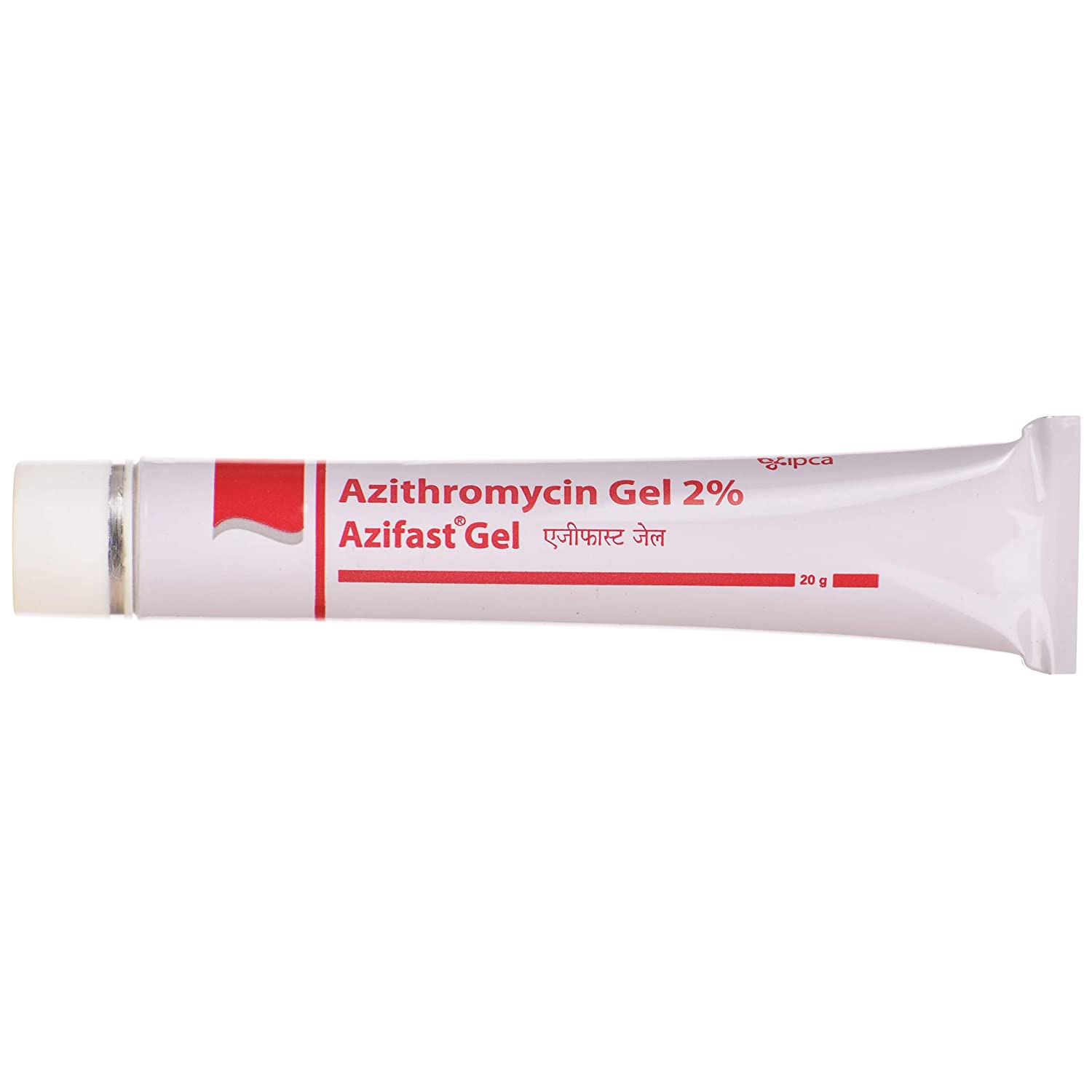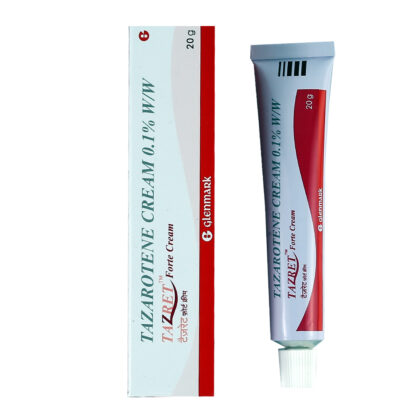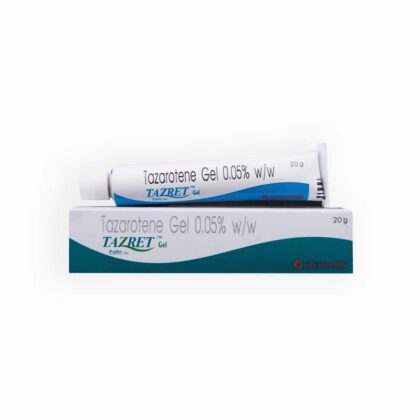Azifast Azithromycin Gel is an antibiotic medicine that fights bacteria. It is used to treat acne, which appears as spots or pimples on your face, chest or back. This medicine works by attacking the germs that cause them. It may also be used to treat minor skin infections.
Azifast Azithromycin Gel is only meant for external use and should be used as advised by your doctor. You should normally wash and dry the affected area before applying a thin layer of the medicine. It should not be applied to broken or damaged skin. Avoid any contact with your eyes, nose, or mouth. Rinse it off with water if you accidentally get it in these areas.
It may take several weeks for your symptoms to improve, but you should keep using this medicine regularly. Do not stop using it as soon as your acne starts to get better. Ask your doctor when you should stop treatment.
Side effects like minor itching, irritation, burning sensation, or redness at the site of application may be seen in some people. These are usually temporary and resolve on their own. Consult your doctor if they bother you or do not go away.
Before using it, you should tell your doctor if you are allergic to any antibiotics. Pregnant or breastfeeding women should consult their doctor before using it.
USES OF AZIFAST GEL
- Acne
- Treatment of Bacterial infections
BENEFITS OF AZIFAST GEL
In Acne
In Treatment of Bacterial infections
SIDE EFFECTS OF AZIFAST GEL
Common side effects of Azifast
- Application site reactions (burning, irritation, itching and redness)
- Vomiting
- Nausea
- Abdominal pain
- Diarrhea
HOW TO USE AZIFAST GEL
HOW AZIFAST GEL WORKS
Azifast Azithromycin Gel is an antibiotic. It works by preventing synthesis of essential proteins required by bacteria to carry out vital functions. Thus, it stops the bacteria from growing, and prevents the infection from spreading.
Quick tips
- Azifast Azithromycin Gel is used to treat bacterial skin infections.
- You may have to use it for a long time before your infection starts to improve. Be patient and keep using it every day.
- Apply it as a thin layer onto affected site on skin.
- It may cause minor burning, stinging, or irritation when applied. Inform your doctor if this does not go away.
- Avoid contact with your eyes, nose or mouth. Rinse it off with water if you accidentally get the cream in these areas.
- If you think the area of skin you are treating has become more irritated and infected, you should stop using Azifast Azithromycin Gel and consult your doctor.
FAQs
Q. How to apply Azifast Azithromycin Gel on acne?
Apply it as a thin layer onto the affected site on the skin. It may cause minor burning, stinging, or irritation when applied. Inform your doctor if this does not go away. Avoid contact with your eyes, nose, or mouth.Q. What precautions are to be taken while using Azifast Azithromycin Gel?
This medicine can make your skin more sensitive to sunlight. Try to avoid exposure to sunlight as much as possible and use sunscreen (SPF 30 or higher) when you are outdoors after consulting your doctor.Q. How long does it take for Azifast Azithromycin Gel to show its effect?
You might start to see an improvement in 6 weeks after using this medicine and takes approximately 8-12 weeks to see the complete effects. Continue with the treatment as long as prescribed by your doctor. The most common reason for treatment failure is giving up too soon, thinking that the treatment is not working. If, however, your skin has not improved even after completing the prescribed time, consult your doctor.Q. When should I call my doctor right away?
Get medical help right away if you have signs of allergic reaction such as skin redness, rash, hives, itching, blisters, and swelling of the face, lips, or tongue.Q. Can I use Azifast Azithromycin Gel with any other face cream or moisturizer?
It is advisable not to use Azifast Azithromycin Gel with other topical anti-acne medicines unless prescribed by your doctor. It can increase the risk of side effects such as skin peeling, irritation, or dryness. However, you can use a sunscreen (SPF 30 or higher) when you are outdoors after consulting your doctor.Q. Why is Azifast Azithromycin Gel given for 3 days?
The duration of treatment depends on the type of infection being treated and the age of the patient. Azifast Azithromycin Gel is not necessarily given for 3 days. In most bacterial infections, a single dose of 500 mg is given for 3 days. Alternatively, it can be given as 500 mg once on day 1 and then 250 mg once from day 2 to day 5. In some cases of infection such as genital ulcer disease, it is given as a single 1 gram dose. Therefore, you must stick to the regime advised by your doctor.Q. What should I avoid while taking Azifast Azithromycin Gel?
Generally, it is recommended that patients taking Azifast Azithromycin Gel should avoid taking any antacid with this medicine as this can affect the overall effectiveness of Azifast Azithromycin Gel. It is also recommended to avoid exposure to sunlight or tanning beds as Azifast Azithromycin Gel increases the risk of sunburn.Q. Is Azifast Azithromycin Gel a strong antibiotic?
Azifast Azithromycin Gel is an effective antibiotic that is used for the treatment of many bacterial infections. Compared to other antibiotics, Azifast Azithromycin Gel has a longer half-life which means that it stays in the body for a long time because of which it is given once a day and for a short span of time. Other antibiotics comparatively have a shorter half-life and are usually given twice, thrice, or four times a day.Q. Can you get a yeast infection from taking Azifast Azithromycin Gel?
Some people may get a fungal or yeast infection known as thrush after taking Azifast Azithromycin Gel. Antibiotics such as Azifast Azithromycin Gel can kill the normal or ‘good bacteria’ of your intestine responsible for preventing thrush. You should inform your doctor if you get a sore or vaginal itching or discharge. Also, inform your doctor if you get a white patch in the mouth or tongue after taking Azifast Azithromycin Gel or soon after stopping it.







Reviews
There are no reviews yet.